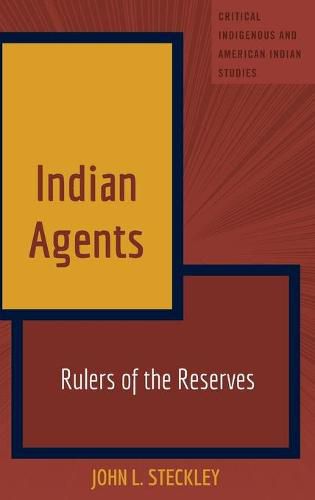Readings Newsletter
Become a Readings Member to make your shopping experience even easier.
Sign in or sign up for free!
You’re not far away from qualifying for FREE standard shipping within Australia
You’ve qualified for FREE standard shipping within Australia
The cart is loading…






This title is printed to order. This book may have been self-published. If so, we cannot guarantee the quality of the content. In the main most books will have gone through the editing process however some may not. We therefore suggest that you be aware of this before ordering this book. If in doubt check either the author or publisher’s details as we are unable to accept any returns unless they are faulty. Please contact us if you have any questions.
Canadians are beginning to learn about the negative effects of residential schools on Aboriginal people in Canada. More hidden in the written record, but bearing a similar powerfully destructive role, are Indian Agents, who were with very few exceptions White men who ‘ruled the reserves’ in Canada from the 1870s to the 1960s. This book is the first to present a discussion of Indian Agents in general. It provides an introductory look at the control Indian Agents exercised over Aboriginal communities throughout the period in question. The primary intent is to spark discussion in Indigenous studies courses.
This book is built upon a discussion of the lives and impact of five Indian Agents: Hayter Reed, William Morris Graham, John McIver, William Halliday, and Fred Hall. However, the practices and views of 39 other Indian Agents are interwoven throughout the text.
Although there was a readily detectable sameness in the way that Indian Agent power was imposed on Aboriginal communities based on the institutional racism of the Indian Agent System, one of the points to be made is that not all Indian Agents were the same. Some were more oppressive than others. Also frequently pointed out is the fact that Aboriginal peoples were not merely helpless victims to Indian Agent control, but resisted that control, sometimes successfully.
The book concludes with a chapter comparing the Indian Agent System in Canada, with similar systems in the United States, Australia, and New Zealand.
$9.00 standard shipping within Australia
FREE standard shipping within Australia for orders over $100.00
Express & International shipping calculated at checkout
This title is printed to order. This book may have been self-published. If so, we cannot guarantee the quality of the content. In the main most books will have gone through the editing process however some may not. We therefore suggest that you be aware of this before ordering this book. If in doubt check either the author or publisher’s details as we are unable to accept any returns unless they are faulty. Please contact us if you have any questions.
Canadians are beginning to learn about the negative effects of residential schools on Aboriginal people in Canada. More hidden in the written record, but bearing a similar powerfully destructive role, are Indian Agents, who were with very few exceptions White men who ‘ruled the reserves’ in Canada from the 1870s to the 1960s. This book is the first to present a discussion of Indian Agents in general. It provides an introductory look at the control Indian Agents exercised over Aboriginal communities throughout the period in question. The primary intent is to spark discussion in Indigenous studies courses.
This book is built upon a discussion of the lives and impact of five Indian Agents: Hayter Reed, William Morris Graham, John McIver, William Halliday, and Fred Hall. However, the practices and views of 39 other Indian Agents are interwoven throughout the text.
Although there was a readily detectable sameness in the way that Indian Agent power was imposed on Aboriginal communities based on the institutional racism of the Indian Agent System, one of the points to be made is that not all Indian Agents were the same. Some were more oppressive than others. Also frequently pointed out is the fact that Aboriginal peoples were not merely helpless victims to Indian Agent control, but resisted that control, sometimes successfully.
The book concludes with a chapter comparing the Indian Agent System in Canada, with similar systems in the United States, Australia, and New Zealand.